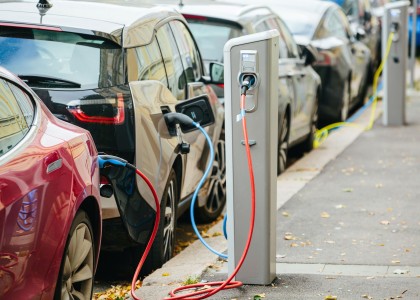Energy efficiency is the "first fuel" in America=s energy policy. Efficiency investment, as the cornerstone of a sound energy policy, must now be accelerated in order to:
- $ Wean America from its addiction to oil and so enhance our national security;
- $ Help American consumers and businesses cope with high energy bills;
- $ Bring balance to America's energy markets by softening energy prices;
- $ Strengthen our economy by generating American jobs and capital investment; and
- $ Start to meet the global warming challenge by moderating carbon dioxide emissions.
Efficiency Is the Engine of Economic Prosperity
The U.S. economy uses half as much energy to produce a dollar of output today as we used in the 1970s. In this context, efficiency is contributing more resource value to the economy than any single energy supply commodity, and has enabled our economy to weather the energy price storms of the last several years. For the near term, efficiency is our only realistic resource and policy choice for meeting these challenges. For the longer term, we will need to accelerate efficiency gains even further as traditional resources become more expensive and scarce.
But what is energy efficiency? More than a concept, efficiency accounts for a very large segment of the U.S. economy. ACEEE estimates that in 2006, total investment in energy supply systems, from pipelines to power plants, totaled about $100 billion. But Americans also invest in energy demand technologies: energy-efficient products bearing the federal Energy Star label accounted for some $101 billion last year, in a range of home and business products. Since Energy Star products account for only about 1/3 of these markets in the aggregate, total revenues are likely in the range of $300 billion annually. And the Energy Star data does not include investments in high-efficiency commercial and industrial technologies, vehicles, combined heat and power systems, and others that would increase the size of the "efficiency economy" still further.
Accelerated Innovation Is Needed to Meet 21st Century Energy Challenges
On March 14, ACEEE joined with Philips Lighting Company and other groups in a 10-year initiative to improve the efficiency of the common light bulb by fourfold or more, saving consumers almost $20 billion in electric bills in 2016 while cutting carbon emissions by up to 140 million tons. This is symbolic of the kind of technology innovation that can transform our energy economy more completely than anything we have seen to date.
Energy efficiency is the essential common element in any policy approach to the unprecedented energy challenges of the 21st century. We must moderate demand growth to enable clean and secure energy sources to wean us from depreciating and dirty sources. This means doubling the rate of progress in energy productivity, through smart energy policies that use a sound mix of regulation and incentives to overcome large and persistent barriers to energy efficiency investment. Effective policies include energy data collection and reporting, research, development, demonstration and deployment, vehicle fuel economy policies, energy efficiency resource standards for utilities, appliance and equipment efficiency standards, and tax incentives.


